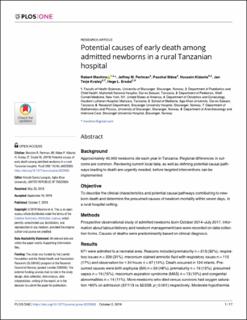| dc.contributor.author | Moshiro, Robert Deogratias | |
| dc.contributor.author | Perlman, Jeffrey M. | |
| dc.contributor.author | Mdoe, Paschal Francis | |
| dc.contributor.author | Hussein, Kidanto | |
| dc.contributor.author | Kvaløy, Jan Terje | |
| dc.contributor.author | Ersdal, Hege Langli | |
| dc.coverage.spatial | Tanzania | en_US |
| dc.date.accessioned | 2020-05-20T13:31:55Z | |
| dc.date.available | 2020-05-20T13:31:55Z | |
| dc.date.created | 2019-12-11T13:24:57Z | |
| dc.date.issued | 2019-10 | |
| dc.identifier.citation | Moshiro, R. D., Perlman, J.M., Mdoe, P. et al. (2019) Potential causes of early death among admitted newborns in a rural Tanzanian hospital. PLOS ONE, 14 (10). | en_US |
| dc.identifier.issn | 1932-6203 | |
| dc.identifier.uri | https://hdl.handle.net/11250/2655206 | |
| dc.description.abstract | Background
Approximately 40,000 newborns die each year in Tanzania. Regional differences in outcome are common. Reviewing current local data, as well as defining potential causal pathways leading to death are urgently needed, before targeted interventions can be implemented
Objective
To describe the clinical characteristics and potential causal pathways contributing to newborn death and determine the presumed causes of newborn mortality within seven days, in a rural hospital setting.
Methods
Prospective observational study of admitted newborns born October 2014–July 2017. Information about labour/delivery and newborn management/care were recorded on data collection forms. Causes of deaths were predominantly based on clinical diagnosis.
Results
671 were admitted to a neonatal area. Reasons included prematurity n = 213 (32%), respiratory issues n = 209 (31%), meconium stained amniotic fluid with respiratory issues n = 115 (17%) and observation for < 24 hours n = 97 (14%). Death occurred in 124 infants. Presumed causes were birth asphyxia (BA) n = 59 (48%), prematurity n = 19 (15%), presumed sepsis n = 19 (15%), meconium aspiration syndrome (MAS) n = 13 (10%) and congenital abnormalities n = 14 (11%). More newborns who died versus survivors had oxygen saturation <60% on admission (37/113 vs 32/258; p≤0.001) respectively. Moderate hypothermia on admission was common i.e. deaths 35.1 (34.6–36.0) vs survivors 35.5 (35.0–36.0)°C (p≤0.001). Term newborns who died versus survivors were fourfold more likely to have received positive pressure ventilation after birth i.e. 4.57 (1.22–17.03) (p<0.02).
Conclusion
Intrapartum-related complications (BA, MAS), prematurity, and presumed sepsis were the leading causes of death. Intrapartum hypoxia, prematurity and attendant complications and presumed sepsis, are major pathways leading to death. Severe hypoxia and hypothermia upon admission are additional contributing factors. Strategies to identify fetuses at risk during labour e.g. improved fetal heart rate monitoring, coupled with timely interventions, and implementation of WHO interventions for preterm newborns, may reduce mortality in this low resource setting. | en_US |
| dc.language.iso | eng | en_US |
| dc.publisher | Public Libary of Science | en_US |
| dc.rights | Navngivelse 4.0 Internasjonal | * |
| dc.rights.uri | http://creativecommons.org/licenses/by/4.0/deed.no | * |
| dc.subject | barnedødelighet | en_US |
| dc.subject | nyfødte barn | en_US |
| dc.title | Potential causes of early death among admitted newborns in a rural Tanzanian hospital | en_US |
| dc.type | Peer reviewed | en_US |
| dc.type | Journal article | en_US |
| dc.description.version | publishedVersion | en_US |
| dc.rights.holder | ©2019 Moshiro et al. | en_US |
| dc.subject.nsi | VDP::Medisinske Fag: 700::Klinisk medisinske fag: 750::Gynekologi og obstetrikk: 756 | en_US |
| dc.source.pagenumber | 17 | en_US |
| dc.source.volume | 14 | en_US |
| dc.source.journal | PLOS ONE | en_US |
| dc.source.issue | 10 | en_US |
| dc.identifier.doi | 10.1371/journal.pone.0222935 | |
| dc.identifier.cristin | 1759310 | |
| cristin.ispublished | true | |
| cristin.fulltext | original | |
| cristin.qualitycode | 1 | |

